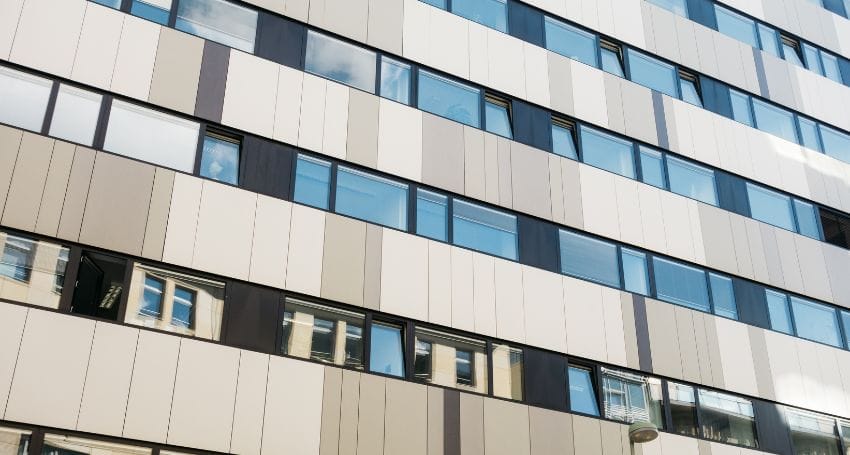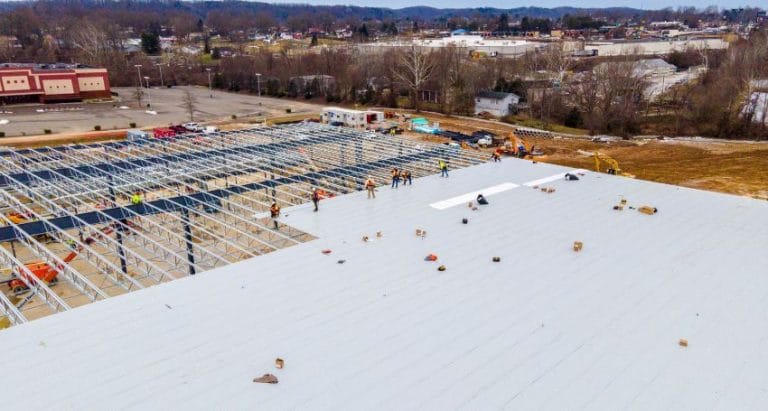In modern architecture, rainscreen cladding has become an essential part of building design, offering both visual appeal and superior weather protection. These systems serve as a protective skin for buildings, keeping rain, moisture, and wind at bay while allowing the structure to breathe.
This guide explores the types of rainscreen cladding, including metal rainscreen cladding, timber rainscreen cladding, stone rainscreen cladding, and more. Whether you’re an architect, builder, or property owner, understanding each option helps you choose the right material for durability, performance, and style.
What Is a Rainscreen Cladding System?
A rainscreen cladding system is an exterior wall cladding system that uses a ventilated façade design to create a gap between the building wall and the cladding panels. This ventilated façade system prevents water ingress while promoting air circulation, helping the wall dry faster and maintain structural integrity.
It’s widely used in both residential and commercial projects because it improves insulation, reduces energy consumption, and enhances aesthetics.
1. Metal Rainscreen Cladding
Among all types of rainscreen cladding, metal rainscreen cladding stands out for its modern look and long-term performance. Metals like zinc, aluminum, copper, and steel are popular due to their strength and flexibility.
Key Benefits:
- High durability and corrosion resistance
- Lightweight and low maintenance
- Available in various textures, colors, and finishes
- Recyclable and eco-friendly
At Zinc & Copper Works, our expertise lies in designing and installing premium metal rainscreen cladding systems that combine elegance with functionality. The aluminum rainscreen system and zinc façade panels are particularly popular for contemporary architectural projects.
Upgrade your façade with Zinc & Copper Works, experts in premium metal rainscreen cladding across the UK.
2. Timber Rainscreen Cladding
If you prefer a warm, natural aesthetic, timber rainscreen cladding is a beautiful and sustainable option. It adds organic texture to building exteriors while maintaining excellent ventilation.
Common Timber Options:
- Cedar: Naturally weather-resistant and lightweight
- Larch: Durable and rich in natural oils
- Oak: Strong and traditional, perfect for classic designs
Advantages:
- Environmentally friendly and renewable
- Offers natural insulation
- Ages beautifully, developing a silver-grey patina
Timber cladding complements eco-friendly architecture and sustainable designs, making it a go-to choice for modern green buildings.
3. Stone Rainscreen Cladding
Stone rainscreen cladding provides timeless elegance and structural durability. Natural materials like granite, limestone, or slate create façades that exude luxury and permanence.
Benefits:
- Exceptional weather resistance
- Long lifespan and low maintenance
- Adds high thermal mass for energy efficiency
- Aesthetically versatile for traditional and modern styles
Although heavier than other cladding types, stone panels enhance building value and architectural integrity, especially in premium projects.
4. Terracotta Rainscreen Panels
Terracotta rainscreen panels are made from fired clay and are known for their natural charm and superior performance. They’re ideal for architects who want to merge earthy aesthetics with modern functionality.
Advantages:
- UV-resistant and color-stable
- Non-combustible and weather-resistant
- Available in various profiles, shapes, and finishes
- Sustainable and recyclable
Terracotta panels bring warmth and texture to façades, often used in educational institutions, museums, and cultural buildings.
5. Ceramic Rainscreen Cladding
Ceramic rainscreen cladding is similar to terracotta but manufactured using advanced technology to achieve precise dimensions and consistent finishes.
Key Benefits:
- High resistance to UV radiation and moisture
- Lightweight yet strong
- Available in glossy, matte, or textured surfaces
This cladding option is perfect for modern façades that demand creativity and performance while maintaining low maintenance.
6. Aluminum and Glass Façade Rainscreen Systems
The aluminum rainscreen system offers exceptional design flexibility with minimal weight, making it suitable for large-scale commercial projects. It pairs beautifully with glass façade rainscreen systems, creating sleek, reflective surfaces that transform building exteriors.
Benefits:
- Lightweight yet strong
- Corrosion-resistant and recyclable
- Modern, high-end appearance
- Ideal for curtain walls and corporate façades
These combinations are widely used in contemporary architecture where innovation and transparency are design priorities.
Benefits of Rainscreen Cladding Systems
Regardless of the material used, all rainscreen cladding systems share key benefits that make them an essential part of modern construction:
- Weather Protection: Prevents moisture penetration and protects the structural wall.
- Energy Efficiency: Improves thermal insulation and reduces heating or cooling costs.
- Aesthetic Flexibility: Available in diverse materials, colors, and designs.
- Low Maintenance: Requires minimal cleaning and upkeep.
- Durability: Extends the building’s lifespan by preventing water damage and corrosion.
These advantages make rainscreen cladding a long-term investment that enhances both form and function.
Contact us today to discover custom rainscreen cladding solutions that combine design, durability, and sustainability.
FAQs about Types of Rainscreen Cladding
1. What is the main purpose of rainscreen cladding?
Rainscreen cladding protects buildings from water infiltration while allowing moisture to evaporate through a ventilated cavity. It also enhances energy efficiency and façade aesthetics.
2. Which material is best for rainscreen cladding?
The best material depends on your project goals. Metal rainscreen cladding offers durability and a modern look, while timber and stone provide natural warmth and character.
3. Are rainscreen cladding systems sustainable?
Yes. Materials like aluminum, timber, and terracotta are recyclable and environmentally friendly, aligning with green building standards.
4. How long does rainscreen cladding last?
Depending on material and maintenance, rainscreen cladding can last anywhere from 40 to 100 years, ensuring long-term value and performance.
5. Does rainscreen cladding improve insulation?
Yes. The ventilated façade system creates an air gap that reduces thermal bridging, improving a building’s insulation and indoor comfort.
Conclusion
Choosing the right type of rainscreen cladding is about balancing aesthetics, performance, and longevity. From the strength of metal cladding to the warmth of timber, each option offers unique advantages tailored to specific architectural goals.
At Zinc & Copper Works, we specialize in designing and installing premium rainscreen cladding systems that not only protect your building but also enhance its beauty and efficiency.




